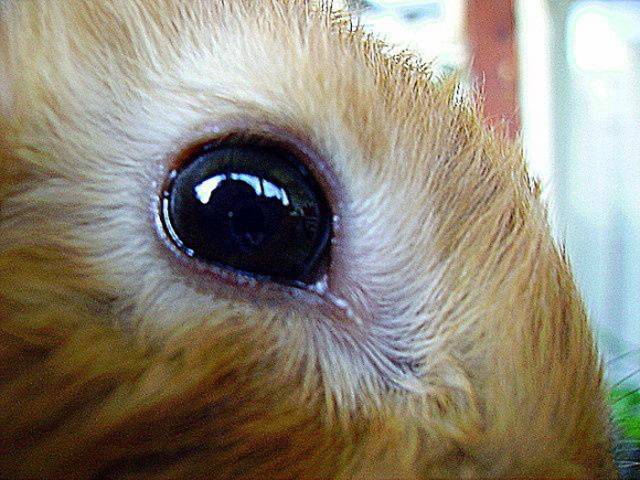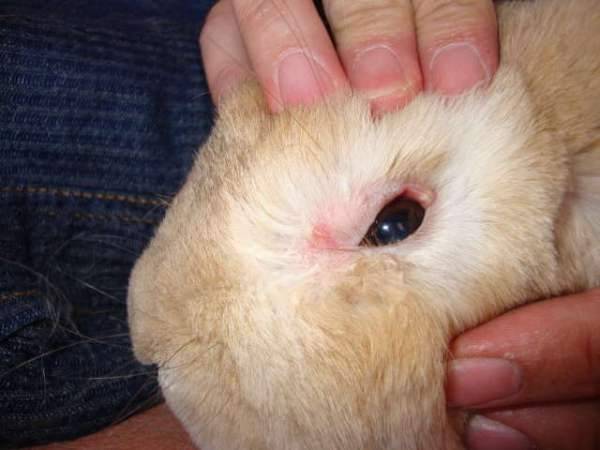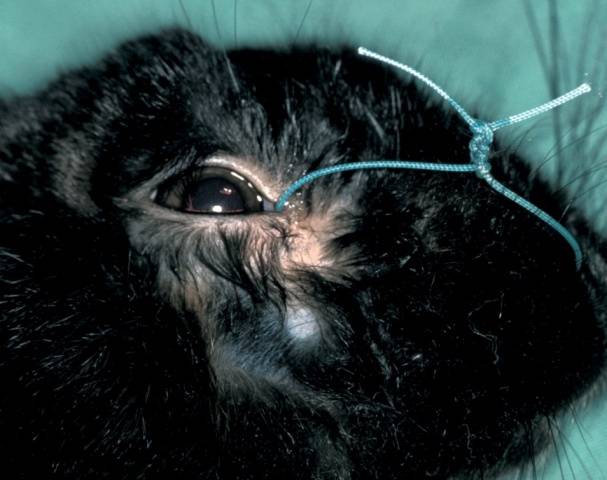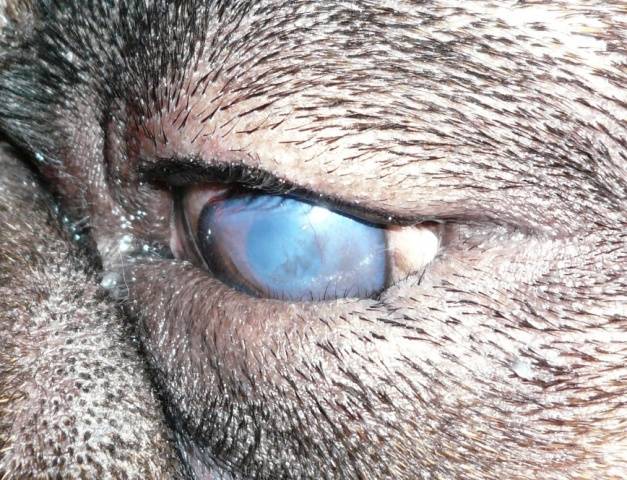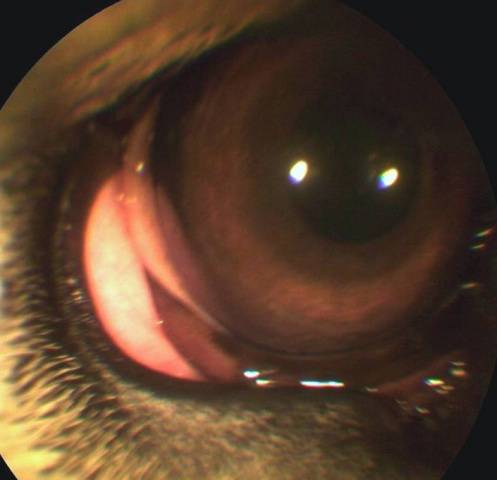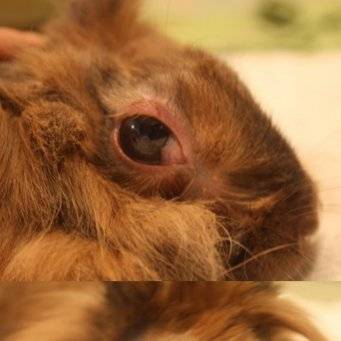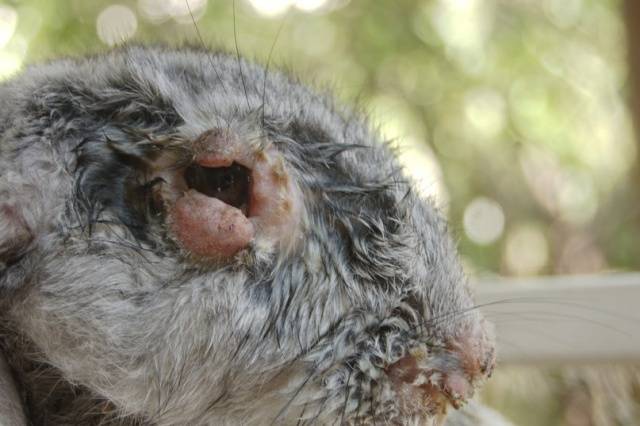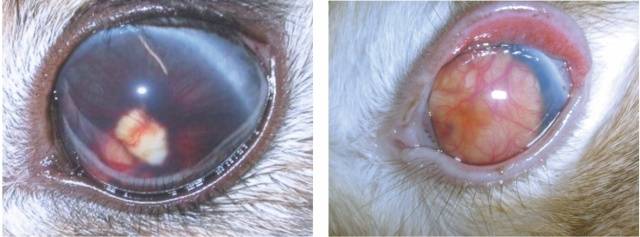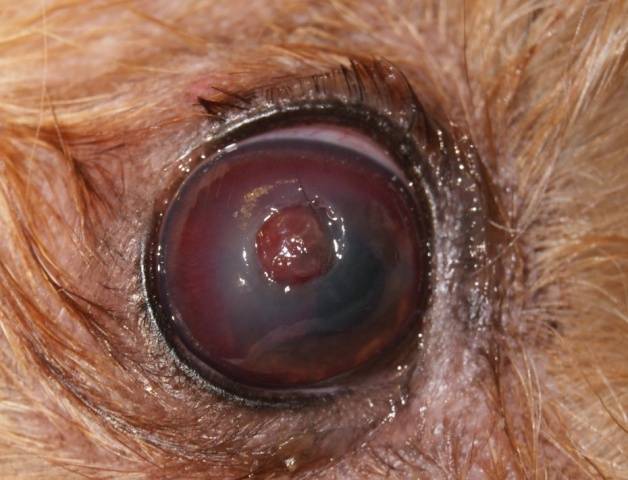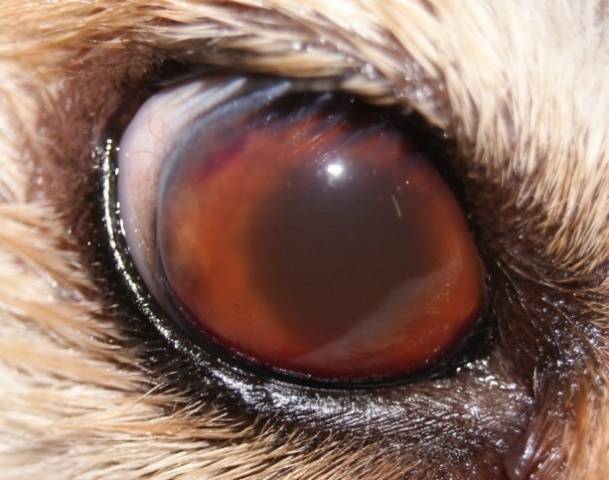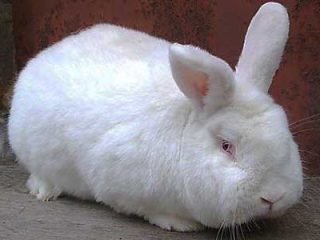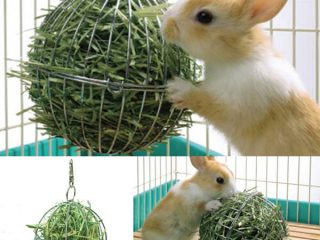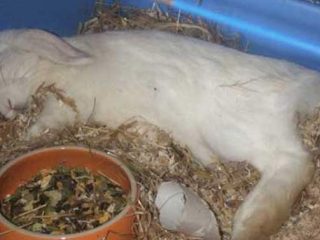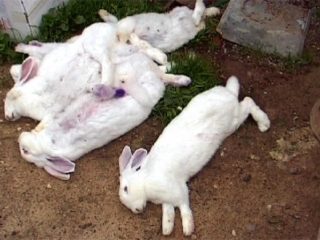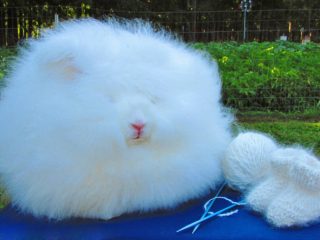Content
Eye diseases in rabbits, unless they are a symptom of an infectious disease, are no different from eye diseases in other mammals, including humans. To the point that a rabbit's eye can be examined and diagnosed by an ophthalmologist.
If conjunctivitis is a symptom of an infectious disease in a rabbit, it is pointless to treat it without eliminating the underlying cause. In this case, the disease is treated first, and symptomatic treatment is applied to the eyes, aimed at making the rabbit feel better.
Diseases of rabbits related only to the eyes are most often of a hereditary nature. May result from mechanical damage, chemical eye irritation, or dacryocystitis, which usually results from congenital malposition of the rabbit's molars.
Eye diseases of an infectious nature must be considered in conjunction with treatment of the underlying disease in a rabbit, so there is no point in dwelling on them in this case.
Non-infectious ocular diseases in rabbits In general, they are treated in the same way as in other animals. The only difference is in size.
Mechanical and chemical damage to the eyes of rabbits and their treatment
Mechanical damage to the eyes of rabbits occurs as a result of fights between animals, piercing the eyes with senins while feeding, bruises if, when frightened, the rabbit stumbles into the corner of a feeder or other object.
Such damage usually goes away on its own, although the eye may look scary. Often in this case there is profuse lacrimation from the eye. The eye is closed. There may be swelling of the eyelids.
To prevent a secondary infection in this case, you can drop drops with a broad-spectrum antibiotic into the rabbit's eyes.
Chemical eye irritation in a rabbit can only be caused by ammonia fumes from decomposing urine in an uncleaned cage. In this case, it is not medical, but sanitary measures that are necessary.
If the eyes are clogged with earth or lime from the walls, the rabbit's eyes are washed with saline solution. If the rabbit's eyes were washed almost immediately after the blockage, then no other measures are required. Otherwise, drops with an antibiotic are instilled.
Your rabbit's eyes may begin to water due to an allergic reaction. In this case, no eye treatment will help until the allergen is identified and eliminated.
Such hay is often called dusty because when shaken, a lot of dust rises into the air, which is actually mold spores. These same spores often cause respiratory tract damage in rabbits.
To eliminate the problem and prevent an allergic reaction in a rabbit, such hay will have to be shed for at least 10 minutes.
Conjunctivitis due to vitamin deficiency
A lack of vitamins can also cause conjunctivitis in a rabbit.This type of conjunctivitis occurs due to a lack of vitamins A or B₂. To eliminate the cause, it is enough to add the missing vitamins to the rabbit’s diet and then monitor the completeness of the rabbit food.
Things are worse if eye diseases in rabbits are caused by hereditary factors or are a complication after other diseases.
Dacryocystitis
An eye disease that is congenital in nature, as it occurs when the molars grow abnormally, which changes the shape of the nasolacrimal duct. As a result, the eye first begins to water, since the secretions of the lacrimal gland are not able to get through the nasolacrimal duct into the nose. The blocked canal becomes inflamed. Later, when a secondary infection settles on the inflamed surface, the discharge becomes purulent.
Treatment is only possible through surgery, as it is necessary to remove abnormally growing teeth. The operation is performed in a veterinary clinic. Accordingly, treatment of dacryocystitis is possible only for decorative rabbits. It’s easier for a farmer to slaughter such a rabbit.
After removing an incorrectly growing tooth, the nasolacrimal duct is cleaned. In advanced cases, drainage is required. Since advanced cases automatically imply suppuration and infection of the canal, antibiotic eye drops are used to eliminate secondary infections.
The photo shows the drainage of the nasolacrimal duct, popularly called a “veil.”
The principle of operation is simple: periodically you need to pull the cord back and forth to clean the channel and get rid of dried mucus.
Entropion of the eyelids
Scientific name: entropium. Occurs as a complication after keratitis. Moreover, entropium itself can be the cause of secondary keratitis.Other causes of entropium: cartilage deformation, long-term conjunctivitis, hereditary predisposition.
Inversion of the eyelids in a rabbit can also occur with convulsive contraction of the orbicularis oculi muscle.
When the eyelids turn in, the eyelashes get caught between the eyelid and the cornea of the eye, damaging it and causing keratitis. If the problem is neglected, the cornea may be perforated.
Torsion can only be corrected surgically. If eye drops do not help your rabbit with conjunctivitis for a long time and the eye continues to fester, you should consult a doctor. Perhaps this is not a matter of ordinary conjunctivitis at all.
Eversion of the eyelids
The reasons are almost the same as for bloat, only instead of convulsive muscle contraction, one of the reasons is paralysis of the facial nerve.
Eversion is characterized by sagging of the eyelid and its separation from the eyeball. As a hereditary factor, it often occurs in dogs with a raw constitution (mastiffs), but in rabbits this phenomenon is very rare and such rabbits should not be allowed to be bred.
Much more often, ectropion of the eyelids in rabbits occurs due to fights or as a complication after an illness.
Eversion of the eyelids is also corrected surgically.
The last of the diseases related to the eyelids is blepharitis.
Blepharitis
This is an inflammation of the eyelids that can lead to ectropion or drooping of the eyelids. Blepharitis can be superficial or deep. The causes of blepharitis in both cases are:
- mechanical damage, that is, burns, wounds, bruises;
- irritation of the eyelids due to chemical, thermal or mechanical effects, that is, sunburn, contact with a caustic substance on the eyelids, and scratching are possible.
You can distinguish between superficial and deep blepharitis by external signs.
Superficial blepharitis has 3 stages:
- The eyelids itch and turn red;
- The edges of the eyelids thicken, flakes of dead skin appear on the eyelids, eyelashes fall out, the palpebral fissure is narrowed, and redness of the conjunctiva is observed;
- Ulcerative blepharitis develops; In place of the eyelashes, pustules form, which, after opening, turn into ulcers. The ciliary margin is wet and bleeding.
Profound blepharitis has no stages. This is an extensive purulent inflammation of the tissue of the eyelids, without the main localization of the abscess in one place. The eyelids are very swollen and painful. The eye is closed. There is pus flowing from the inner corner of the eye. The conjunctiva swells and protrudes into the palpebral fissure.
Treatment of blepharitis
For superficial blepharitis, you can use lotions made from a 1% solution of baking soda. The edges of the eyelids are treated with antimicrobial ointments: furatsilin or svfacil sodium.
Antibiotics and sulfonamides are used as a general remedy. The same drugs are used in the treatment of deep blepharitis. If localized abscesses appear, they are opened.
Conjunctivitis
The general name for inflammatory processes in the mucous membrane between the eyelid and the eyeball.
The causes of conjunctivitis in rabbits can be mechanical and chemical factors.Mechanical ones include eye irritation from dust or a piece of hay that gets on the mucous membrane. Chemicals: cauterizing agents, disinfectants, lime dust, acids, alkali, ammonia in poorly ventilated areas.
Symptoms for conjunctivitis are the same:
- itching;
- blepharospasm, that is, spontaneous closure of the eye;
- photophobia;
- discharge from the inner corner of the eye;
- soreness of the eyelids.
Discharge from the eyes with conjunctivitis can be clear or purulent. The latter usually occurs either with an underlying infectious disease or with advanced non-contagious conjunctivitis.
There are 5 forms of conjunctivitis:
- acute catarrhal conjunctivitis;
- chronic catarrhal conjunctivitis;
- purulent conjunctivitis;
- fibrinous conjunctivitis;
- follicular conjunctivitis.
In acute conjunctivitis, lacrimation, photophobia, and redness of the mucous membranes of the eye are observed. If acute conjunctivitis is not treated, it will become chronic with purulent discharge.
Often, conjunctivitis is provoked by pathogenic microflora that have become hooked on damage to the mucous membrane or have taken advantage of the weakened immunity of the rabbit.
Treatment of conjunctivitis
First of all, the cause of conjunctivitis is eliminated. The eyes are washed with weak disinfectant solutions: potassium permanganate or furatsilin. For catarrhal conjunctivitis, astringent solutions are recommended, of which boric acid is the most well-known and widespread. The eyes are washed with a 3% solution of boric acid.
In purulent forms, intramuscular injections of antibiotics are used to destroy pathogenic microflora. For topical use, eye ointments and drops with broad-spectrum antibiotics are used.
Keratitis
Inflammation of the cornea of the eyeball. The causes of the disease are the same as those of conjunctivitis.
The main symptom of keratitis: clouding of the cornea. With purulent keratitis, the cloudiness will be yellow. In addition to clouding, there is photophobia, exfoliated particles of the epithelium, and growth of the cornea with additional blood vessels.
Treatment of keratitis
Eliminate the cause and prescribe eye ointments or drops with antibiotics.
Corneal ulcer
Ulcers occur with glaucoma, lack of tear fluid due to blockage of the nasolacrimal duct, or damage to the facial nerve.
An ulcer is a perforation of the cornea of the eye. Surgery to remove the eyeball is usually required.
Uveitis
Usually this is a concomitant disease. Occurs with advanced keratitis or corneal ulcer, as well as with infectious diseases. Essentially, uveitis is an inflammation of the uvea of the eye. The underlying disease is treated.
Conclusion
All eye diseases of rabbits require professional medical intervention. Treatment of eye diseases in productive rabbits is usually not profitable in monetary terms, with the exception of mild forms of conjunctivitis. Owners usually decide whether to treat decorative rabbits depending on their capabilities.
